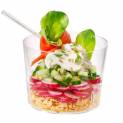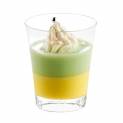
Paper Coffee Cups in the Beverage Industry
Coffee cups play an important role in the consumption and distribution of one of the most beloved beverages in the world. Modern paper coffee cups have evolved from traditional ceramic cups. Sweet Flavor explores the basics of paper coffee cups, exploring their composition, features, benefits, variants, usage, challenges, and tips for choosing them.
Paper Coffee Cups Composition
Paper coffee cups are typically composed of several layers of materials to provide insulation, structural integrity, and resistance to liquid. The composition of a standard paper coffee cup includes:
Outer Paper Layer: This is the outermost layer of the cup, providing a surface for branding, printing, or labeling. It's usually made of paperboard, which is thicker and sturdier than regular paper.
Polyethylene Coating: To make the cup waterproof and prevent leakage, a thin layer of polyethylene plastic is applied to the inner surface of the paperboard. This coating also helps to retain heat and insulate the cup.
Paperboard Body: The main body of the cup is made from paperboard, which is a thick, heavy-duty type of paper. It provides the structure and shape of the cup.
Insulating Air Gap: Between the paperboard layers, there may be an air gap that helps to insulate the cup, keeping the beverage hot and the outer surface cool enough to hold comfortably.
Features of Paper Coffee Cups
Insulation Properties: Paper coffee cups are designed to maintain the temperature of hot beverages while remaining comfortable to hold. The combination of paperboard and polyethylene provides adequate insulation without compromising on recyclability.
Compatibility with Lids: One of the essential features of paper coffee cups is their compatibility with lids. Whether it's a plastic lid for added convenience or a compostable lid for eco-conscious consumers, paper cups can accommodate various lid options.
Benefits of Paper Coffee Cups
Convenience: Paper coffee cups are lightweight and disposable, making them convenient for both customers and businesses. They eliminate the need for washing and can be easily discarded after use, saving time and effort.
Insulation: Many paper coffee cups are designed with insulating materials or layers to help keep beverages hot while preventing the outer surface of the cup from becoming too hot to handle comfortably. This insulation ensures that customers can enjoy their coffee at the desired temperature without the need for additional sleeves or holders.
Customization: Paper coffee cups offer businesses the opportunity to customize the design with their logo, branding, or promotional messages. This customization helps businesses enhance their brand visibility and create a unique experience for their customers.
Portability: Paper coffee cups are portable and easy to carry, making them ideal for on-the-go consumption. Whether customers are commuting to work, running errands, or enjoying outdoor activities, paper coffee cups allow them to enjoy their favorite beverages conveniently.
Eco-Friendly: Paper coffee cups are now made from recycled materials or are biodegradable/compostable. These eco-friendly options help reduce the environmental impact of disposable cups and align with customers' sustainability preferences.
Safety: Paper coffee cups are generally considered safe for serving hot beverages, as they are designed to withstand high temperatures without leaching harmful chemicals into the drink. Additionally, the polyethylene coating used in many paper cups helps prevent leaks and spills, minimizing the risk of accidents.
Cost-Effective: Compared to reusable alternatives, paper coffee cups are often more cost-effective for businesses, especially those with high-volume coffee sales. They eliminate the need for upfront investments in expensive reusable cups and reduce expenses associated with cleaning and maintenance.
Common Variants of Paper Coffee Cups
Single-Wall Cups: These are the most basic variant of paper coffee cups, featuring a single layer of paperboard. While they provide adequate insulation, they are best suited for moderate temperature beverages.
Double-Wall Cups: Double-wall cups feature an additional layer of insulation, making them suitable for hot beverages like espresso and cappuccino. They offer superior heat retention and a comfortable grip.
Ripple-Wall Cups: Ripple wall coffee cups are designed with a corrugated inner layer that enhances insulation and prevents heat transfer to the outer surface. They are ideal for serving piping hot drinks without the need for sleeves.
Tips for Choosing the Right Paper Coffee Cups
Size: Consider the volume of coffee typically served and choose cup sizes accordingly, ranging from small (8 oz) to extra-large (20 oz) to accommodate different preferences.
Insulation: Opt for cups with good insulation to keep beverages hot for longer periods, ensuring customer satisfaction and reducing the need for additional sleeves.
Durability: Select cups made from sturdy paperboard materials to prevent leaks, spills, and collapsing, especially for takeaway or on-the-go consumption.
Eco-Friendliness: Choose cups made from recycled materials or those that are biodegradable/compostable to align with environmental values and reduce carbon footprint.
Compatibility with Lids: Ensure that the chosen cups are compatible with matching lids to prevent spills, retain heat, and offer added convenience for customers.
Cost-Effectiveness: Consider the overall cost, including bulk discounts and shipping fees, to find cups that offer the best value without compromising quality or functionality.
Conclusion
Coffee cups made from paper offer convenience, sustainability, and versatility, revolutionizing the way we enjoy beverages. Advances in materials and consumer awareness are driving change in the industry despite challenges such as recycling. Paper coffee cups can make coffee-drinking more sustainable and enjoyable by understanding the basics and making informed choices.










